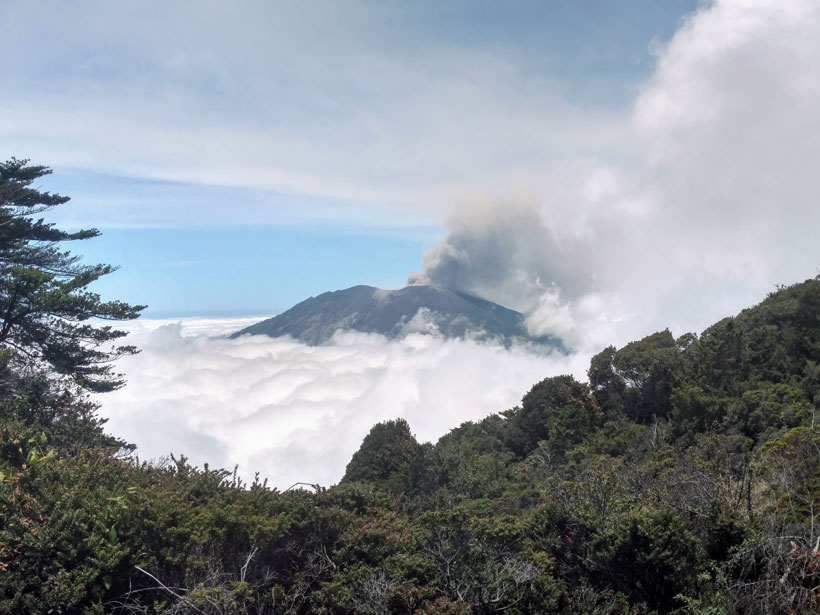Tropical forests absorb more carbon dioxide than any other terrestrial ecosystem, helping modulate the climate of the entire planet. But no one knows how tropical forests will respond as carbon dioxide (CO2) levels continue to rise.
“As we emit more CO2, how much CO2 are those forests going to absorb? Are they going to saturate? Do they run out of nutrients?” asked Joshua Fisher of NASA’s Jet Propulsion Laboratory in Pasadena, Calif.
“We think that there is a crystal ball into the future of the Earth hidden in the jungles of Costa Rica’s volcanoes.”
Scientists are motivated to gather experimental data on what Fisher calls “one of the biggest uncertainties in all climate projections of the entire Earth,” but artificially exposing forested areas to sustained high CO2 levels is expensive, is technically challenging, and has, thus far, been accomplished only in temperate regions.
However, Fisher and a team of interdisciplinary scientists have published a paper describing a promising new way to investigate the effects of high CO2 levels in tropical forests, utilizing a pair of active volcanoes in Costa Rica. The volcanoes, Irazú and Turrialba, seep CO2 along their densely forested slopes, creating a natural controlled experiment, as high-CO2 areas can be compared to low-CO2 areas in the same forest.
“We think that there is a crystal ball into the future of the Earth hidden in the jungles of Costa Rica’s volcanoes,” said Fisher.
Using Volcanoes to Study Forests
The volcanic system could be considered a good experimental model only if the trees were actually assimilating the volcanic CO2. The researchers measured the amounts of CO2 being emitted at the base of individual trees and then analyzed tissue samples from those trees. They found that the trees were taking up the volcanic CO2 at a rate proportional to the amount they were exposed to.
“This [study] identifies the approach as one that has promise and deserves some more attention,” said Michael Keller, a biogeochemist at the U.S. Forest Service’s International Institute of Tropical Forestry who was not involved in the research. “It’s interesting. It’s exciting. It’s innovative.” He also pointed out that there are many other volcanoes around the world that could be candidate study sites.
Using Forests to Study Volcanoes
Robert Bogue, a volcanologist, lead author on the paper, and a Ph.D. candidate at McGill University in Montreal, said that this forested volcanic system could also be used to study volcanoes themselves.
Increases in seeping CO2 emissions can foretell volcanic eruptions, but because of remoteness and resource constraints, most volcanoes are not continuously monitored. Without a historical record, a scientist taking CO2 measurements at a volcano for the first time would have no way of knowing whether they were seeing a relatively elevated CO2 release rate.
Trees could be an ally in addressing this problem because many trees generate a discrete growth ring each year. Researchers regularly compare the chemical features of these rings to glean information about annual changes in the environment. Now that volcanologists know that local trees assimilate CO2 at a rate proportional to release, they may be able to “retroactively create that record because these trees have been passively creating this archive of CO2 degassing,” said Bogue. “That can give you some idea of if what you’re seeing is alarming.”
After a volcanic eruption, volcanologists could potentially analyze surviving trees “and maybe see some patterns in the years before that could then serve as a warning signal for the future,” Bogue added.
The researchers also found that one of the three tree species they evaluated exhibited leaf fluorescence values that correlated with volcanic CO2 levels. Leaf fluorescence (often called chlorophyll fluorescence) is light reemitted by leaves that have been exposed to the Sun or an artificial light source.
Changes in leaf fluorescence can be detected by satellites and other flyover monitoring technology. If, through more research, volcanologists are able to model the effects of volcanic CO2 on leaf fluorescence, they could potentially monitor volcanoes without even having to visit them.
“The power of satellites for this sort of work, I think, can’t really be understated,” said Bogue, “especially once [volcanoes are] starting to get potentially more active and dangerous, which is when you arguably want the data the most…So being able to take these measurements from something that can’t get blown up by the volcano is very cool.”
Bogue and his collaborators’ paper was published in Biogeosciences.
—Kate S. Petersen ([email protected]), Program in Science Writing, Massachusetts Institute of Technology, Cambridge
Citation:
Petersen, K. S. (2020), Forests respond to volcanic emissions, Eos, 101, https://doi.org/10.1029/2020EO138654. Published on 15 January 2020.
Text © 2020. The authors. CC BY-NC-ND 3.0
Except where otherwise noted, images are subject to copyright. Any reuse without express permission from the copyright owner is prohibited.

